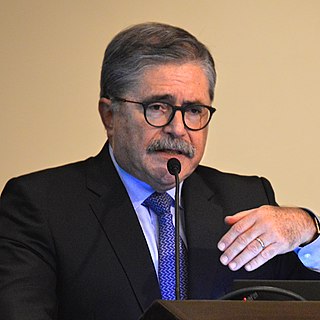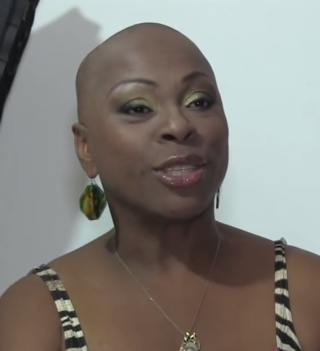Antisemitism in Costa Rica refers to the anti-Jewish sentiment and prejudice in the Republic of Costa Rica.
| Part of a series on |
| Antisemitism |
|---|
 |
Antisemitism in Costa Rica refers to the anti-Jewish sentiment and prejudice in the Republic of Costa Rica.
The first Jews arriving to Costa Rica were mostly Sephardic Jews from Spain escaping persecution. Most of them New Christians. [1] Although some may have been crypto-Jewish it is impossible to know how many were Roman Catholics and how many were not.
As part of the Spanish Empire the Spanish Inquisition was in place in the province of Costa Rica, however there's no registry of any Jew ever to have been trialed or executed, as the only registry of an Inquisition trial in Costa Rica was against a couple of young women accused of Witchcraft who were absolved. [2]
After gaining independence the first Costa Rican Constitution, the Pact of Concord of 1821 established the Catholic religion as the mandatory religion (not only official but compulsory) banning all other creeds for the citizens of Costa Rica and only allowing the practice of other religions for foreigners who were temporary in the country. [3] This, of course, affected the Jews already living in the country who had to practice their religion in secret, inspiring the myth of the "witches of Escazú". Escazú had one of the largest Jewish communities and the Jewish rites (using black clothes and speaking in "strange languages" [Hebrew] among other things made some observers to think that it was some sort of magical ritual). [4] However freedom of religion was established in the following Constitution, 1925's Fundamental Law of the State of Costa Rica as in the Federal Republic of Central America in general of which the State of Costa Rica was a member, allowing Jews to practice freely. [3]
Successive migration from Sephardic Jews from places like Curacao, Panama and Jamaica faced relative tranquility, though Jews did not have their own graveyard and Sephardic Jews were buried (alongside Protestants, Muslims, Baháʼís and other minorities) in the Foreigners’ Cemetery, a practice that continues to this date. [5] After the foundation of Freemasonry in Costa Rica anti-Masonic publications mostly from the Church also associated Masonry with Judaism, as did the publication of the anti-Masonic Catholic party, the Catholic Union in 1891 accusing it of being the "flesh and bones of Talmudism". [6]
The first major waves of Jewish migrations came in the late 19th century and early 20th century mainly from Ashkenazi Polish Jews who did not mix with the Sephardic. [7]
These migratory waves escaping the European anti-Semitism and the rise of Nazism were controversial in the Costa Rican society and caused heated debates in the press, [7] producing also a large number of anti-Semitic articles and the births of far-right anti-Semitic groups like the Patriotic Union and the Anti-Jewish Committee. [1] [8] Anti-Semitic laws were enacted during President León Cortés Castro's administration. Cortés was a well known anti-Semite and Fascist sympathizer. [9] Future president Otilio Ulate also spread anti-Semitic canards in his own newspaper even accusing Jews of poisoning the milk of children and was a prominent anti-Semite. [7]
During the interwar period the NSDAP/AO tried the nazification of the Costa Rican German community, [10] [11] which was led by engineer Max Effinger, who would be a minister in Cortes' cabinet. [1] The issue split the German community among pro and anti-Nazis. [12] [13] [14] [15]
Cortes' successor, Dr. Rafael Ángel Calderón Guardia, has also being accused of anti-Semitic and anti-Masonic ideas, however Calderón was closer to Spanish National Catholicism than any form of Fascism and was loyal to the United States even visiting the White House during his tenure. After the Pearl Harbor attack Calderón declared war on Germany and aligned the country with the Allies following a persecution of Germans, Italians and Japanese (including Effinger who was deported to the United States although release after the war). However most laws limiting the rights of Jews were kept in place until Calderón successor's presidency, Teodoro Picado Michalski, himself son of a Polish mother and thus friendly toward the Polish Jewish community. [7]
The outbreak of the Costa Rican Civil War after the 1948 election in which Otilio Ulate was the alleged winner split the country in two sides; opponents and supporters of the government. The Jewish community was seen as pro-government whilst Germans and Italians were overwhelmingly anti-Calderón due to the persecutions. After the triumph of rebel forces the Synagogue of San José was set on fire, but no more anti-Semitic attacks happened in part due to the opposition of war caudillo José Figueres. [7]
Most of post–1948 period of Costa Rica was characterized by its political stability. The country developed a two-party system between the center-left Figueristas and center-right Calderonistas and in general avoided the extremes with both far-left and far-right parties receiving testimonial results. Costa Rica (as a founding member of the United Nations) was also one of the countries that voted in favor of the creation of Israel and for many years was alongside El Salvador one of the only two countries with the embassy in Jerusalem and not Tel Aviv. During the Cold war period the far-right Free Costa Rica Movement was born and active, with a strong paramilitary anti-leftist organization. Although some members of the group were openly anti-Zionist others were simply Conservative and Libertarian hardliners whose anti-Communism was not mixed with anti-Jewish ideas.
Controversies regarding Luis Fishman's Jewishness arise during the 2002 Costa Rican general election when presidential candidate Abel Pacheco de la Espriella separated Fishman as his running mate in the presidential ticket. Fishman accused Pacheco and his team of making anti-Semitic comments. [16] On the 2010–2014 period, then deputy Manrique Oviedo of the Citizens' Action Party (although he later defected to National Restoration) accused then Vice President Luis Liberman of using his influence for benefiting a fellow Jew. [17]
And in 2019 anti-establishment right-wing candidate Juan Diego Castro generated uproar due to his video making accusation against businessman and newspaper owner Leonel Baruch, of Jewish origin, calling him "evil banker" and mocking the Holocaust. [18] Anti-semitic comments have been reported in social media including against Eliécer Feinzaig, president of the Liberal Progressive Party and of Jewish religion. [19]
Around the early 2000s the so call National Socialist Party of Costa Rica was founded, mainly as a fringe neo-Nazi group, accused of minor violent hate crimes and vandalism, but with little to non impact in Costa Rican politics aside from the media coverage. [20] Some other minor neo-Nazi groups also appeared with mostly online activity. [21] In 2012 a police officer identify as Ronald "Murdock" Herrera Borges came into the spotlight for his association with Nazism and being openly neo-Nazi. [22] [23] Herrera was fired from the police [24] and committed suicide a few years later. [25] [26] In 2015 the Simon Wiesenthal Center denounced that shops selling Holocaust denial literature and Nazi symbols existed in San José. [27]
In 2018 an anti-immigration rally was controversial due to the presence of neo-Nazis in it using Swastikas and Nazi salutes and administrating far-right Facebook pages that spread xenophobic material and Fake news. [28] [29] [30] Several far-right organization were dismantled during the 2019 including a terrorist group that owned one of these pages named Resistencia Costarricense (Costa Rican Resistance). [31]
A 2009 poll measuring the perception of Jews in Costa Rica showed that 32% of Costa Rican have a positive view of the Jews, whilst 29% have a negative and 38% have neither. [32] 8% of Costa Rican considered Jews to be honest citizens, 10% considered that they help each other, 4.7% considered that they help the economy, 4.5% believed they respect the family and 4.8% that they have a clear identity. [32] 7.5% of Costa Ricans believed that Jews discriminate non-Jews, 6.5% believed they exploit who works for them, 11% that they know how to handle money and 4% believed they disrespect the Christian faith. Negative ideas were more prominent among men than women. [32]
Only 1.3% expressed they distrusted Jews (the most distrusted group was that of the Colombian immigrants at 34%), and only 0.5% expressed that they have a problem with Judaism as a religion (65% expressed no problem with any religion), 67% expressed no problem with Jewish institutions, 13% express a little of discomfort and only 7% expressed a lot of discomfort. [32] 37% thought that Jews should be more loyal to Costa Rica than to Israel, and 35% were indifferent if they were. [32] 41% of Ticos answered that they think the Jews killed Christ or took part in his death, whilst 37% do not answer and 21% think the Jews were not responsible. [32]

Costa Rican culture has been heavily influenced by Spanish culture ever since the Spanish colonization of the Americas including the territory which today forms Costa Rica. Parts of the country have other strong cultural influences, including the Caribbean province of Limón and the Cordillera de Talamanca which are influenced by Jamaican immigrants and indigenous native people, respectively.

The Nazi Party/Foreign Organization was a branch of the Nazi Party and the 43rd and only non-territorial Gau ("region") of the Party. In German, the organization is referred to as NSDAP/AO, "AO" being the abbreviation of the German compound word Auslands-Organisation. Although Auslands-Organisation would be correctly written as one word, the Nazis chose an obsolete spelling with a hyphen.
Víctor Ernesto Farías Soto is a Chilean historian. Farías is best known for his controversial book Heidegger and Nazism (1987).
Same-sex marriage has been legal in Costa Rica since May 26, 2020 as a result of a ruling by the Supreme Court of Justice. Costa Rica was the first country in Central America to recognize and perform same-sex marriages.
Costa Rica's official and predominant language is Spanish. The variety spoken there, Costa Rican Spanish, is a form of Central American Spanish.

Christianity is the predominant religion in Costa Rica, with Catholicism being its largest denomination. Catholicism is also the state religion, but the government generally upholds people's religious freedom in practice.
The history of the Jews in Costa Rica dates back to the Spanish conquest with the arrival of many Sephardic converts known as Marranos who escaped from the Spanish Inquisition and settled mainly in the city of Cartago and its surroundings. They hid their Jewish past by all means, making even their descendants have no idea of it.

International relations between Argentina and Israel, have existed for decades. Both countries established diplomatic relations on May 31, 1949.

Costa Ricans are the citizens of Costa Rica, a multiethnic, Spanish-speaking nation in Central America. Costa Ricans are predominantly Castizos, other ethnic groups people of Indigenous, European, African and Asian descent.

Antisemitism in Spain has its roots in Christian anti-Judaism which began with the expansion of Christianity on the Iberian Peninsula during the rule of the Roman Empire. Its first violent manifestation occurred in the brutal persecution of Jews in Visigothic Hispania. During the Middle Ages, Jews in Islamic-occupied Spain, Al-Andalus, were designated as dhimmis, and, despite occasional violent outbursts such as the 1066 Granada massacre, they were granted protection to profess their religion in exchange of abiding to certain conditions that limited their rights in relation to Muslims. After the Almoravid invasion in the 11th century, the situation of the Jewish population in Muslim territory worsened, and during the Almohad invasion of the peninsula, many Jews fled to the northern Christian kingdoms, the eastern Mediterranean and the more tolerant Muslim areas in North Africa.

The Jewish Archive was the name given to a collection of documents compiled by the regime of Francisco Franco in Spain during the Second World War. In accordance with instructions of the Directorate of General Security the provincial governors of Spain assembled records of all Jews who lived in Spain, whether or not they were Spanish. Jorge Martínez Reverte has suggested that the resulting list, which recorded 6,000 Jews living in Spain, was handed to Heinrich Himmler's SS in 1941 and was included in Adolf Eichmann's Jewish Population Census, tabled at the Wannsee Conference, chaired by Reinhard Heydrich, in January 1942.

Juan Diego Castro Fernández is a Costa Rican lawyer and politician, former Grand Master of the Grand Lodge of Costa Rica. Castro is a Defense lawyer who studied Law and Criminal science at the University of Costa Rica and has a Doctorate degree in Mediation from Universidad La Salle. Castro was Minister of Public Safety between 1994 and 1997 during the presidency of José María Figueres (PLN). He became the first cabinet member to receive a Motion of no confidence by the Legislative Assembly when he summoned police forces to fence off Parliament as a means to press for the reform of the Penal Code. Subsequently, Castro resigned as Minister of Safety and was named Minister of Justice. He unsuccessfully ran for the presidency as the nominee of the conservative-leaning National Integration Party in the 2018 Costa Rican general election. Castro has been compared unfavorably to US President Donald Trump and other right-wing antiestablishment and right-wing populist figures.

Gonzalo Justo Facio Segreda was a Costa Rican lawyer, politician, and diplomat.

The First Costa Rican Republic is the name given to the historical period between the proclamation of the Republic of Costa Rica in the 1848 reformed Constitution and the official decree by then President José María Castro Madriz on 31 August 1848 and the Costa Rican Civil War of 1948 which ended with the enactment of the current 1949 Constitution on 7 November 1949 starting the Second Costa Rican Republic.

The Reform State or Reformist State is a period in Costa Rican history characterized by a change in the political and economic paradigm. During this period, the country switched from the uncontrolled capitalism and laissez faire approach of the Liberal State into a more economically progressive Welfare State. The period ranges from approximately 1940, starting with the presidency of social reformer Rafael Angel Calderón Guardia, and ends around the 1980s with the neoliberal reforms inherent in the Washington Consensus that began after the government of Luis Alberto Monge.
Social Guarantees were a series of progressive political reforms made in Costa Rica in the 1940s for the benefit of the working classes. They came about as a result of the alliance between various political and religious figures. Though a widespreads effort, there were three main leaders:

Mauricio Herrera Ulloa is a Costa Rican journalist and the current Costa Rican ambassador to Honduras. Herrera was previously the Minister of Communication under the presidency of Luis Guillermo Solís, the chief editor of the University of Costa Rica's newspaper Semanario Universidad, the Director of Communications at the Center for Justice and International Law, and the defendant of the landmark case Herrera Ulloa vs. Costa Rica before the Inter-American Court of Human Rights.

Thelma Darkings Bucknam is a Costa Rican actress and television presenter. She is known for hosting the Costa Rican talk show programs Conectados and previously Entre nos. Her film credits include Noi siamo angeli (1997), Caribe (2004), and El último comandante (2010).
Rocío Aguilar Montoya is a Costa Rican politician. She was the eleventh Comptroller General of the Republic of Costa Rica (2005-2012). Between May 2018 and October 2019, she was the Minister of Finance.
{{cite journal}}: Cite journal requires |journal= (help){{cite book}}: |work= ignored (help)